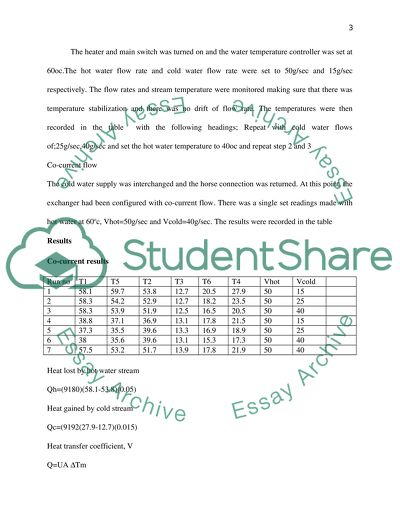CHECK THESE SAMPLES OF Heat transfer in a water-water heat exchanger
… Shell and tube heat exchangers in their various construction modifications are probably the most widespread and commonly used basic heat exchanger configuration in the process industries.... In countercurrent heat exchanger type, average temperature variation between the process streams is optimized over the exchanger's length, showing the highest heat transfer rate efficiency over a surface area unit.... Counterflow and parallel heat exchangers are illustrated below, Figure 1: Counterflow and parallel heat exchangers The design of shell and tube heat exchanger depends on flow pattern through the respective heat exchanger....
7 Pages
(1750 words)
Coursework
heat exchanger Design Project heat exchanger Design Name: Institution: 1 Objective The objective of the project is to come up with an elaborate design of a heat exchanger.... The Flowrate of the system is to be designed to be 10,560 kg/hr The design also aims at getting the heat exchanger using hot Ethylene glycol which at the inlet shall be at a temperature of 350 K.... 2 Background Shell and Tube Heat Exchangers A shell and tube heat exchanger works with the principle that a series of parallel tubes run through a shell that is filled with a fluid that takes the heat from the series of parallel tubes....
11 Pages
(2750 words)
Coursework
A heat exchanger cools distillates.... The columns use an air cooled heat exchanger for cooling.... A heat exchanger is equipment built for transfer of heat from one medium to another, efficiently (Nellis & Klein, 2009).... The air cooled heat exchanger is a pressure vessel whose function is to cool the circulating fluid in finned tubes by forcing ambient air, by directing the heat to water or air.... The objective of using an air cooled heat exchanger is to increase the efficiency of a plant, and its environmentally friendly effect of not requiring an auxiliary supply of water and no water treatment chemicals required, compared to cooling tower counterparts....
4 Pages
(1000 words)
Essay
A pump pumps water from the tank, through the flow regulator and the heat exchanger and back to the tank.
Plate heat exchanger is suitable for applications with limited space… Heat transfer through the circuits is through the metal plates and gasket which have holes for both hot and cold water to pass.... he counter flow heat exchanger creates a more uniform temperature difference between a cold and hot water; thus the counter flow heat exchangers have higher efficiencies compared to parallel flow heat...
16 Pages
(4000 words)
Coursework
The main aim of this experiment is to enable the students familiarize with the shell and tube heat exchanger and to determine the overall efficiency of the current rates of different fluids.... In comparison to the counter current, the overall heat exchanger for concurrent flow is under control since there was a significant change for counter current has a significant change.... This shows that the efficiency of the heat exchanger effects on parallel flow more than counter flow....
9 Pages
(2250 words)
Essay
The company needs to develop the heat exchanger, the connections, the sensors and the control system.... A two-year independent study of heat exchanger systems installed in Britain's houses observed a savings of 380 kWh and 500 kWh per person annually (AIMC4, 2014).... The heat exchanger technology is being provided by LEED in the United States (Moore, 2013).... The type of heat exchanger that the company is developing is very...
10 Pages
(2500 words)
Essay
Solar Plates are used to heat the coolant and transmit the heat to the drain back tank, which then heats the water and stores it in an insulated tank.... he principle of the solar water heater system is based on a series of painted flat plates used to absorb heat from the sun to heat the water.... The main difference between these types is the use of external power: While active solar heating systems use fans or heat pumps to circulate and transfer the heat energy, passive solar heating systems heat the water by using the solar energy directly....
5 Pages
(1250 words)
Coursework
This work called "Heat Transfer from Stream to Water" focuses on the experiment: the Corning heat exchanger and then Heating Liquids contained in Tank Storage.... nbsp;The experiment comprises water stirred tank, a centrifugal pump that pushes the water from the tank to a heat exchanger tube, and an external shell that later directs the water back to the original tank.... The experiment's main source of heat is steam condensation that enters the heat exchanger shell side through the stream inlet....
6 Pages
(1500 words)
Research Paper


